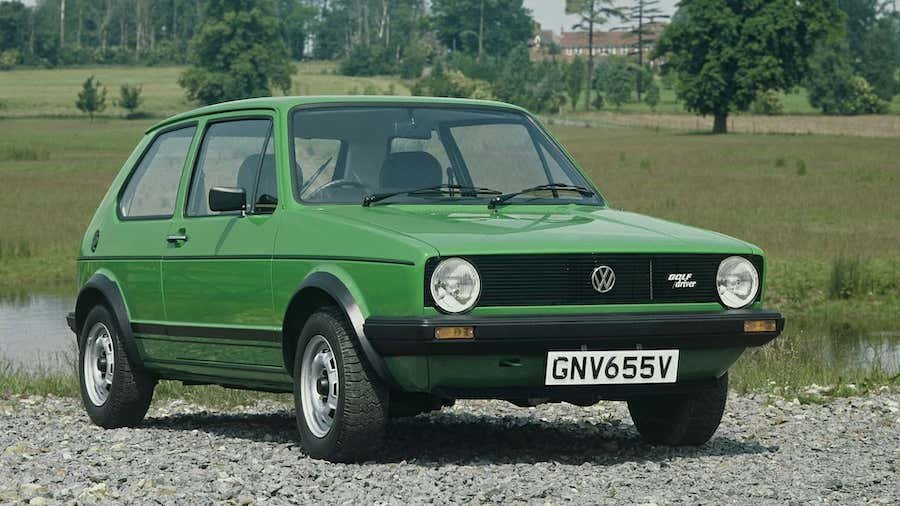The VW Golf Mk1 Will Soon Be 50 And It's Already A Legend

What’s the difference between a generally important model for a certain brand and a model that redefines the company’s future? An easy explanation could be this – the Passat is one of Volkswagen’s most important models on a global scale but the Golf is a true icon that has its own place in the history of the entire automotive industry. It marked a revolutionary shift for the Wolfsburg-based brand, replacing the legendary Beetle and setting the stage for a new era of compact cars.
Next year, the Golf nameplate turns 50 and VW will present historic Golf models from its collection on numerous occasions. But before we enter the celebrations for the model's anniversary, let's talk about why it was so special.
Welcome to Timeless European Treasures, our weekly look back at cars from the European market that defined a motoring generation.
Why Do We Love It?
Undoubtedly, the Volkswagen Golf is still remembered as being a breakthrough model not only for Volkswagen but for the entire industry. As a replacement for the beloved Beetle, it represented a departure from tradition and signaled Volkswagen's transition from rear-wheel drive and rear-mounted air-cooled engines to front-wheel drive with front-mounted, water-cooled engines – a groundbreaking shift that defined a new era for the brand.
It was more than just a popular car, though. For many people from all around the world, this was the first car they ever bought brand new. It was a very reliable car that could easily do the job of a daily driver and was very easy to maintain. On top of that, it was very frugal making it the perfect choice for young families.
Lest we forget about the Volkswagen Golf GTI. One of the hot hatch pioneers, it was launched in 1976 and quickly became popular with its more powerful engine, larger tires, and sportier design tweaks. The total production of the GTI version far exceeded VW's expectations, reaching more than 462,000 units during the vehicle's lifecycle. It is still regarded as the ancestor of all modern hot hatches but according to some, that is debatable since models such as the 1967 Simca 1100 Ti and the 1971 Autobianchi A112 Abarth arrived earlier.
When Was The Car Launched?
The Volkswagen Golf made its debut in Europe in May 1974. It took Volkswagen more than two decades to complete the final concept and design of the replacement for the Beetle. The process involved dozens of prototypes with different engine layouts, overall shapes, and interior designs. The final design of the Golf was known as the Type 17.
The Volkswagen Golf Mk1 went into production in March 1974, and sales officially began in May of the same year. About a year later, the hatchback reached the US market under the Rabbit moniker. The first examples of this car were manufactured in Germany and exported to North America. In 1978, VW started local production of the model at its Westmoreland plant.
What Engines Did It Have?
Depending on the market, the first-gen Golf was sold with a range of inline-four engines with a displacement of between 1,093 cc and 1,781 cc. The most powerful GTI models had either a 1.6- or 1.8-liter engine depending on the model year with power of up to 110 horsepower. Two years after its initial launch, the hatch also got a 1.5-liter diesel mill, later replaced by a larger 1.6-liter unit in naturally aspirated and turbocharged forms.
As far as the design is concerned, Giugiaro's involvement in the development process commenced in January 1970 when he was invited to Wolfsburg. He was tasked with a design brief outlining a C-segment car featuring a two-box body in both three- and five-door versions. Giugiaro infused his design with his distinctive "origami" or "folded-paper" style, characterized by sharp corners and flat planes. Notably, he would later regard the Mk1 Golf as the pinnacle of his career in design.
Did It Sell Well?
The success of the first-generation Golf was nothing short of remarkable. The car quickly gained popularity, and by 1976, Volkswagen celebrated the sale of the first million units. Upon its discontinuation, more than six million units were produced and delivered to customers around the globe. The model was so popular and successful in certain regions that VW kept producing it in a modified form on the South African market for the next 25 years.
Over time, the cumulative sales of all Golf generations made it the most successful European car and the best-selling Volkswagen of all time, with over 37 million units delivered to date. The next chapter of the legacy will be unveiled in January next year with the launch of the facelifted Golf Mk8.
Here’s One Fun Fact About The Golf
In 1975, Volkswagen introduced air conditioning as an option in its home market. While that’s interesting enough for a small car in the middle of the 1970s, one other fact amazed us from today’s perspective – the automaker offered a retrofit AC option to existing Golf owners together with a larger battery.



Related News
